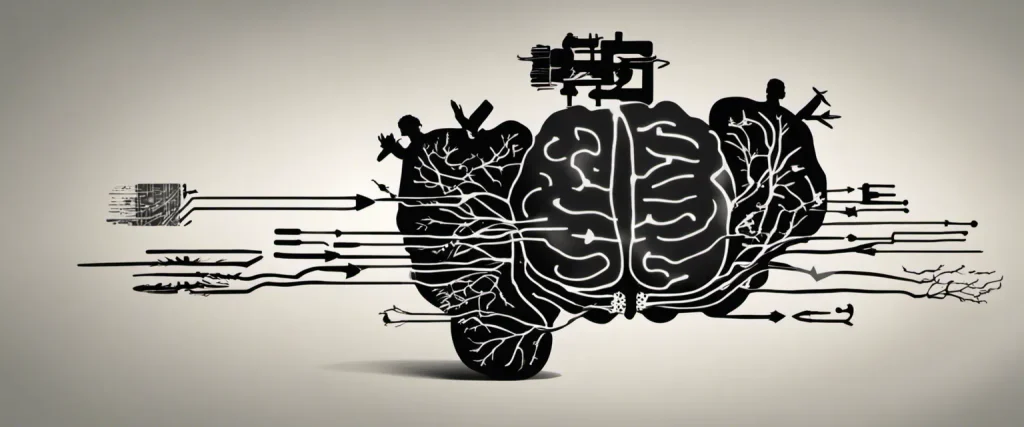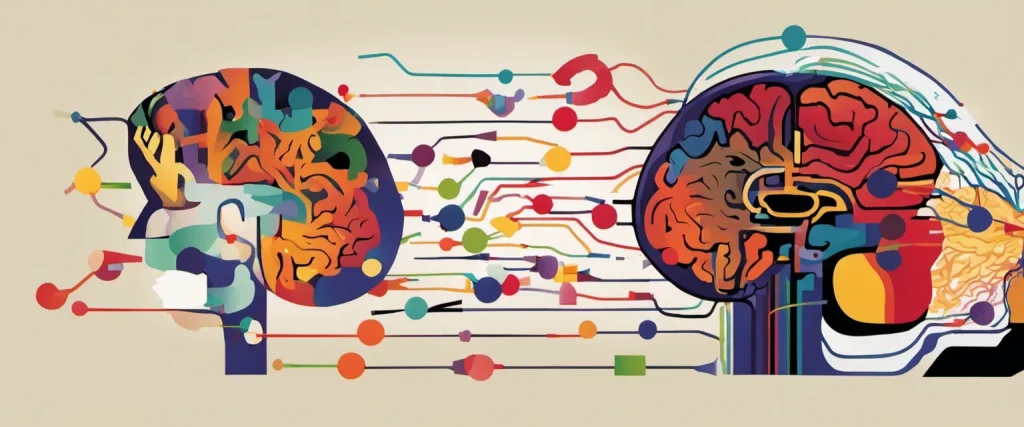In “The Brain that Changes Itself,” author Norman Doidge explores the fascinating field of neuroplasticity, revealing groundbreaking scientific research that challenges conventional beliefs about the brain. This bestselling book showcases the brain’s remarkable ability to rewire itself, even in the face of seemingly insurmountable challenges such as stroke, learning disorders, or physical disabilities. Doidge, a renowned psychiatrist and psychoanalyst, delves into the profound implications of these discoveries and presents compelling case studies, highlighting individuals who have undergone remarkable neurological transformations. His work sheds light on a new era of brain plasticity research, offering hope and inspiration for individuals seeking to overcome cognitive limitations and unlock their potential.
Chapter 1: The Brain That Changes Itself
Chapter 1: The Brain That Changes Itself introduces the concept of neuroplasticity, which challenges the long-standing belief that the human brain is fixed and unchangeable. Norman Doidge presents real-life stories of individuals who have experienced remarkable transformations and recoveries from various neurological conditions through neuroplasticity.
Doidge begins with the story of Dr. Paul Bach-y-Rita, a neuroscientist who revolutionized the field by demonstrating that the brain can adapt and reroute functions. He developed a device called a “tactile-visual sensory substitution system” that allowed blind individuals to process visual information through touch. The brain, it turns out, could be trained to process this new sensory input and develop visual capabilities.
The chapter also discusses the case of a woman named Cheryl, who at the age of fifty-eight suffered a massive stroke that left her paralyzed on her right side. Traditional therapy failed to produce any significant improvements, but she discovered the astonishing effects of constraint-induced movement therapy. This approach entailed forcing her paralyzed arm to move systematically, which eventually led to a significant recovery.
Furthermore, the chapter explores the work of psychiatrist and psychoanalyst Dr. Jeffrey Schwartz, who focuses on obsessive-compulsive disorder (OCD). Schwartz found that through a combination of cognitive techniques and medication, patients with OCD were able to rewire their brains and reduce their symptoms significantly.
Doidge emphasizes that these stories and others give hope to individuals who have previously been told they cannot change or recover. He highlights the remarkable adaptability and plasticity of the brain, showing that it has the capacity to rewire neural circuits, form new connections, and adapt to new circumstances.
Overall, Chapter 1 serves as an introduction to the idea that the brain is not fixed and unchangeable but has the potential to change and heal itself, opening up new possibilities for treating neurological conditions.
Chapter 2: Building Herself a Better Brain
Chapter 2 of “The Brain that Changes Itself” by Norman Doidge is titled “Building Herself a Better Brain.” In this chapter, Doidge explores the story of Barbara Arrowsmith-Young, a woman who experienced various cognitive difficulties from childhood. Arrowsmith-Young was struggling with lifelong learning deficits and was diagnosed with a series of learning disabilities, including dyslexia and processing problems.
Arrowsmith-Young became determined to improve her brain function and set out on a journey to develop cognitive exercises that would target her weaknesses. She studied psychology and neuroscience, and with the help of experts, she designed a series of exercises to target specific cognitive functions. These exercises were aimed at stimulating the areas of her brain that were underdeveloped or weak.
Doidge explains the principles behind Arrowsmith-Young’s exercises, which are based on the brain’s neuroplasticity – its ability to change and reorganize in response to experience. He describes how her exercises were designed to create new neural connections and strengthen existing ones, leading to improved cognitive abilities.
Through her diligent practice, Arrowsmith-Young noticed gradual improvements in her cognitive abilities, such as improved visual perception, mental imagery, and problem-solving skills. She eventually founded the Arrowsmith School, where she developed a program to help students with learning disabilities by employing similar cognitive exercises.
Doidge highlights Arrowsmith-Young’s story as an example of the brain’s ability to change and rewire itself, challenging the conventional belief that learning disabilities cannot be overcome. By demonstrating the power of focused cognitive exercises, he provides hope for individuals with learning difficulties and emphasizes the importance of recognizing and tapping into the brain’s capacity for neuroplasticity.
Chapter 3: Redesigning the Brain
Chapter 3 of “The Brain that Changes Itself” by Norman Doidge focuses on the concept of brain plasticity and the remarkable ability of the brain to rewire and reorganize itself. The chapter begins with the story of Cheryl Schiltz, a middle-aged woman who was left partially blind from a stroke. Despite being told by medical professionals that her visual impairment was permanent and irreversible, Cheryl refused to accept this diagnosis and began searching for alternative treatments.
Doidge then introduces the concept of “constraint-induced movement therapy” (CI therapy) developed by Dr. Edward Taub. This therapy involves restraining the unaffected limb to force the stroke-affected limb to regain functionality. Through intensive and repetitive training, Cheryl’s brain gradually rewired itself, and she regained some of her vision and functionality.
The chapter also explores the fascinating case of Barbara Arrowsmith Young, a woman with various learning disabilities resulting from specific brain dysfunctions. Young pursued a career in education and started developing cognitive exercises to target and improve the specific areas of her brain that were affected. Eventually, she founded the Arrowsmith School, where students with learning disabilities participate in her cognitive exercises. The results have been remarkable, with many students improving their cognitive abilities and transforming their lives.
Overall, Chapter 3 highlights stories of individuals who have challenged the traditional beliefs about brain limitations and have pushed the boundaries of brain plasticity. It emphasizes the power of neuroplasticity and how the brain can adapt and redesign itself, offering hope for those suffering from various neurological conditions and disabilities.
Chapter 4: Acquiring Tastes and Loves

Chapter 4 of “The Brain that Changes Itself” by Norman Doidge, titled “Acquiring Tastes and Loves,” delves into the plasticity of the brain and explores how our brains can adapt to new tastes and generate new passions.
The chapter begins by introducing the story of Dr. Paul Bach-y-Rita, a renowned neuroscientist who developed a device called the “tongue stimulator” to help blind people “see” by translating visual information into tactile sensations on the tongue. This groundbreaking invention demonstrated the brain’s ability to repurpose itself to process sensory information from alternative sources. Bach-y-Rita’s work opened up a new world of possibilities for neuroplasticity.
Doidge then proceeds to discuss a phenomenon called “cultural neuroplasticity,” which refers to the brain’s capacity to adapt to cultural experiences, including acquiring new tastes. He narrates the story of a woman named Cheryl Schiltz, who, after years of aversion to cilantro, developed a sudden desire for the herb. Through various interviews and research, the author explores how cultural experiences, including exposure to new foods and environments, can lead to the rewiring and reprogramming of the brain’s neural networks.
Furthermore, Doidge delves into the concept of “neuroesthetics,” where the brain reshapes itself to develop new passions and aesthetic preferences. He describes the journey of a music lover named John Pepper, who lost his ability to enjoy music due to a stroke. However, through intense rehabilitation and repetitive listening, Pepper was able to rebuild his appreciation for music, emphasizing the brain’s astounding adaptability.
Overall, Chapter 4 emphasizes how the brain can rewire itself to develop new tastes and passions through neuroplasticity. It highlights inspiring stories of individuals who have experienced personal transformations through cultural and sensory adaptation and serves as a reminder of the brain’s remarkable capacity for change and growth.
Chapter 5: Maps in the Brain
Chapter 5: Maps in the Brain of “The Brain that Changes Itself” by Norman Doidge delves into the fascinating concept of brain maps. Doidge explores how the brain is organized into various maps that represent different parts of the body and the world around us.
The chapter begins by highlighting the discoveries of the Canadian neurosurgeon Wilder Penfield, who pioneered brain mapping techniques in the 1930s. By electrically stimulating different regions of the brain during surgeries, Penfield was able to create maps of the sensory and motor functions of the brain. His work revealed the precise organization of these functions, with different areas of the brain corresponding to specific parts of the body.
Doidge then progresses to the story of Cheryl Schiltz, a woman who lost the use of her left arm due to a stroke. However, through intensive rehabilitation that involved visualizing and mentally moving her paralyzed arm, she regained partial use. This astonishing result challenged the long-held belief in the medical community that the brain’s territory for an affected area becomes permanently taken over by other functions.
The chapter also discusses the phenomenon of phantom limbs, where amputees continue to feel sensations or movement in a limb that no longer exists. Researcher V.S. Ramachandran conducted experiments using mirror therapy to rewire the brain’s representation of the phantom limb, leading to the alleviation of phantom limb pain and providing evidence of neuroplasticity—the brain’s ability to rewire itself.
Doidge further explores how repeated practice can reshape the brain’s maps and improve motor skills. He introduces the case of Barbara Arrowsmith Young, who developed cognitive exercises to target her own learning disabilities and subsequently established a school to help others. The chapter concludes by emphasizing the remarkable plasticity of the brain and its ability to reorganize itself through various experiences and therapies, providing hope for individuals with neurological conditions.
Chapter 6: Altered States
Chapter 6 of “The Brain that Changes Itself” by Norman Doidge, titled “Brain Lock Unlocked: Using Plasticity to Stop Worries, Obsessions, Compulsions, and Bad Habits,” explores the concept of neuroplasticity in relation to treating conditions such as Obsessive-Compulsive Disorder (OCD) and other forms of habitual behaviors.
Doidge begins by introducing Jeffrey Schwartz, a psychiatrist who helps individuals suffering from OCD through a technique called cognitive-behavioral therapy (CBT). Schwartz developed this approach based on the understanding that OCD stems from an overactive circuit in the brain that creates excessive worry and repetitive thoughts. Through CBT, he teaches patients to observe their thoughts, detach from them, and intentionally redirect their attention to healthier alternatives.
The chapter delves into the scientific mechanisms underlying Schwartz’s technique and how it aligns with neuroplasticity. It explains that repeated and focused attention on new thoughts or behaviors leads to the strengthening of neural pathways, while withdrawing attention from old pathways allows them to weaken and fade away. By redirecting attention, patients can rewire their brains and alleviate their symptoms.
Doidge then explores how this neuroplastic approach applies to other conditions, such as phantom limb pain and chronic pain. Many patients have successfully used mental exercises to train their brains to perceive reduced pain or even eliminate it altogether.
The chapter concludes with an exploration of the potential use of neuroplasticity in addiction treatment. It introduces the example of an experimental technique called deep brain stimulation, which shows promise in reducing addictive behaviors by targeting specific brain areas associated with cravings and reward.
In summary, Chapter 6 of “The Brain that Changes Itself” highlights the potential of neuroplasticity in treating various conditions characterized by dysfunctional brain circuits. It emphasizes the role of attention redirection and repeated mental exercises in rewiring the brain, providing hope for individuals suffering from OCD, chronic pain, and addictions.
Chapter 7: Turning Our Ghosts into Ancestors
Chapter 7 of “The Brain that Changes Itself” by Norman Doidge is titled “Turning Our Ghosts into Ancestors.” In this chapter, Doidge explores the concept of neuroplasticity and how it can be harnessed to overcome traumatic experiences and psychological distress.
Doidge begins by introducing the work of psychiatrist Michael Merzenich, who conducted groundbreaking research on how the brain can rewire itself. Merzenich’s studies focused on patients suffering from phantom limb pain, where amputees still experience pain in the missing limb. By using a process called cortical reorganization, Merzenich discovered that the brain could be trained to alleviate this pain. He found that by manipulating sensory input, such as using mirrors or virtual reality, patients could gradually reprogram their brains, effectively turning their “ghost” limbs into mere “ancestors.”
Furthermore, Doidge explores the work of psychologist Jeffrey Schwartz, who developed a therapy known as the Four Steps Approach to help patients with obsessive-compulsive disorder (OCD). Schwartz’s approach involves teaching patients to observe their intrusive thoughts without acting on them, actively refocusing their attention, and ultimately rewiring their brains to break the OCD cycle. This process relies on the principles of neuroplasticity to reshape the brain and create new thought patterns.
Doidge also delves into the concept of morphic resonance proposed by biologist Rupert Sheldrake. This theory suggests that certain behaviors or experiences can become ingrained in a collective consciousness, making it easier for individuals to adopt those behaviors or experience similar events. This idea has profound implications for neuroplasticity, implying that the brain can tap into a larger pool of experiences and potentially learn from the past.
Overall, Chapter 7 of “The Brain that Changes Itself” demonstrates the incredible capacity of the brain to adapt and rewire itself. It highlights the potential of neuroplasticity to heal trauma, alleviate pain, and overcome psychological disorders through techniques that transform “ghosts” into “ancestors.”

Chapter 8: The Culturally Modified Brain
Chapter 8 of “The Brain that Changes Itself” by Norman Doidge is titled “The Culturally Modified Brain.” In this chapter, Doidge explores how our brains are shaped and modified by cultural factors and external influences.
Doidge begins by discussing how our brains are not only shaped by genetic predispositions but are also influenced by our cultural environment. He highlights various studies that demonstrate the plasticity of the brain when exposed to different cultures and languages. For example, he describes research conducted with deaf individuals who use sign language and how their brains adapt to process visual stimuli instead of auditory input.
The chapter delves into the fascinating concept of neuroplasticity and how it interacts with our cultural experiences. Doidge explains that cultural practices, such as reading or writing, can rewire our brains and allow us to acquire new skills. He emphasizes the importance of education and stimulating environments in shaping neural connections and enhancing cognitive abilities.
Through case studies, Doidge provides compelling examples of individuals who have undergone remarkable brain changes due to cultural modifications. He shares stories of stroke patients who recover their speech by participating in singing therapy, as well as individuals with learning disabilities who improve their reading skills through specialized programs.
In conclusion, Chapter 8 explores how cultural factors shape and modify our brains. It highlights the incredible plasticity of our neural networks and emphasizes the importance of creating enriching cultural and educational environments for optimal brain development. The chapter underscores the notion that our brains are constantly evolving and adapting to the world around us.
After Reading
In conclusion, “The Brain That Changes Itself” by Norman Doidge is a captivating exploration of the brain’s remarkable capacity for adaptation and transformation. This groundbreaking book introduces us to numerous case studies that highlight the brain’s ability to rewire itself, even in the face of seemingly insurmountable challenges. Doidge challenges the long-held belief that the brain is fixed and unchangeable, providing hope and inspiration for individuals with neurological conditions. By illustrating the power of neuroplasticity through real-life stories, Doidge presents a compelling argument for the limitless potential of our brains to heal, learn, and grow.
1. Why Buddhism Is True” by Robert Wright
In this thought-provoking book, Robert Wright combines a scientific and philosophical approach to Buddhism, exploring how its teachings align with modern understandings of the mind and human nature. He examines the fundamental principles of Buddhism, including the concept of self, meditation, and mindfulness, and provides compelling arguments for the relevance of Buddhist teachings in our modern world.
2. Anticancer: A New Way of Life” by David Servan-Schreiber
Drawing on his personal experience as a cancer survivor and his background as a medical doctor and neuroscientist, David Servan-Schreiber offers a revolutionary perspective on preventing and treating cancer. Through a mix of research, practical advice, and inspiring personal anecdotes, he outlines a comprehensive approach to cancer prevention and highlights the importance of lifestyle changes, nutrition, and emotional well-being in supporting conventional treatments.
3. The Gene: An Intimate History” by Siddhartha Mukherjee
Building on the knowledge gained from “The Brain that Changes Itself,” Siddhartha Mukherjee embarks on an exploration of the gene’s profound influence on our lives. With engaging storytelling and rigorous scientific research, Mukherjee delves into the history, discovery, and implications of genetics, and delves into the ethical and philosophical questions that arise as we unveil the secrets of our genetic code.
4. Outliers: The Story of Success” by Malcolm Gladwell
In this captivating book, Malcolm Gladwell challenges conventional notions of success by examining the factors that contribute to exceptional achievements. Ranging from cultural legacies to personal motivation and opportunity, Gladwell explores the hidden patterns that shape successful individuals and offers valuable insights for anyone looking to understand their own potential and the world around them.
5. Sapiens: A Brief History of Humankind” by Yuval Noah Harari
Taking a sweeping view of human history, Yuval Noah Harari presents a compelling account of the development of our species. From the Cognitive Revolution to the Scientific Revolution, Harari explores the key events and forces that have shaped humanity. With a unique blend of anthropology, history, and philosophy, “Sapiens” invites readers to challenge their perspectives and reflect on the past while contemplating the future of our species.
These book recommendations will complement your reading of “The Brain that Changes Itself” and provide fascinating insights into topics ranging from Buddhism and cancer to genetics, success, and the history of human civilization.




Comments
Nice post. I learn something totally new and challenging on websites